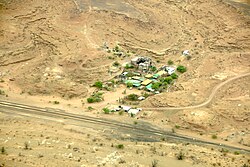This article needs to be updated.(October 2020) |

Seeheim railway station is a railway station serving the settlement of Seeheim in southern Namibia. [1] It is part of the TransNamib Railway, and is located along the line that leads from Windhoek southwards.
Contents
At Seeheim the railway splits; one line continues to Upington, connecting Namibia with South Africa, the other one once led to Lüderitz. The passenger line to Lüderitz has been defunct for many years because the rails were destroyed between Aus and Lüderitz. [2] This missing section is currently being rebuilt. Until its estimated finish in 2010, the few irregular passenger trains to the West end in Aus.